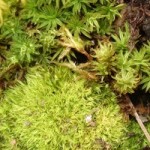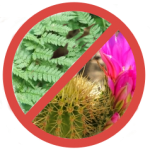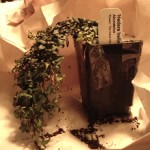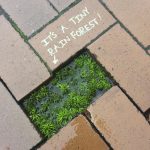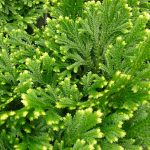Mystery Moss
Even when it’s your own backyard, going on a moss hunt can be exciting. You just don’t know what you might find. It might be something rare or it might just be one of the most common plants found throughout the world. Oddly enough, it is sometimes the more common things that are the hardest to name. In this case it is some upright moss that reminds me a bit of teeny palm trees crossed with hemlock trees.
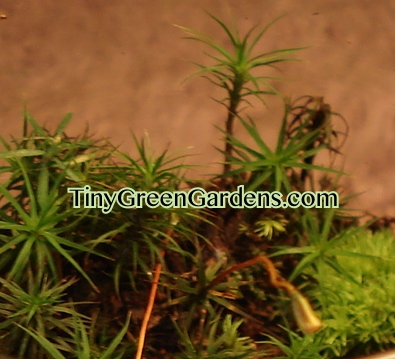 Moss appears to be one of those tricky things to identify. There are over 12,000 species of mosses and some can only be identified through DNA testing – something definitely not in this tiny green gardener’s budget. So, my identification is based upon photos and descriptions made by others.
Moss appears to be one of those tricky things to identify. There are over 12,000 species of mosses and some can only be identified through DNA testing – something definitely not in this tiny green gardener’s budget. So, my identification is based upon photos and descriptions made by others.
Not Star Moss
I originally thought they might be a form of star moss. Star moss is a name that seems to be given to any upright moss that has leaves growing from a central stem. Some species seem to be favored by aquariests. Unfortunately, many aquarium supply stores are selling terrestrial species as water dwellers and that can lead to all sorts of problems when the wrong one is planted in an aquarium. The experts on the aquarium forums seem to be of the mind, if the moss is shipped in dirt; it is most likely not safe for an aquarium.
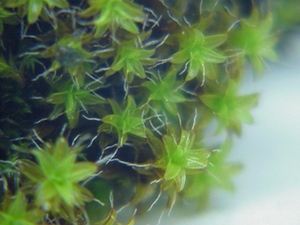 My little moss seems to have many of the characteristics of Tortula ruralis – a species often referred to as star moss or twisted moss. (We all have Kurt Stueber to thank for this great photo of tortula ruralis including the glasshairs that help identify this species.) It grows in an upright fashion, has leaves the grow in a spiral around a central stem and has distinguishable roots. All features that could describe my moss – except for the glasshairs and the width of the leaves. And, while my little moss does has the same interesting way of expressing it’s displeasure about not having enough water, it’s not star moss.
My little moss seems to have many of the characteristics of Tortula ruralis – a species often referred to as star moss or twisted moss. (We all have Kurt Stueber to thank for this great photo of tortula ruralis including the glasshairs that help identify this species.) It grows in an upright fashion, has leaves the grow in a spiral around a central stem and has distinguishable roots. All features that could describe my moss – except for the glasshairs and the width of the leaves. And, while my little moss does has the same interesting way of expressing it’s displeasure about not having enough water, it’s not star moss.
The leaves on star moss are wider and don’t have the Hemlock or pine-tree like leaves my moss does. (An earlier backwoods expedition did lead to the discovery of some more leafy-looking specimens, but this latest batch has much thinner leaves.) Also, if you look straight down on star moss, it looks a bit like a star. Mine looks a bit like a Moravian Star but doesn’t just seem like Tortula ruralis.
Too Short to be Dawsonia
I recently found a photo of Dawsonia. It looks a lot like my mystery moss. Only problem is, it is only found on the other side of the world in Australia, New Zealand, New Guinea, Indonesia, Malysia and Australia. I suppose it’s possible that one of the many birds who visit our back woods could have brought some Dawsonia along for the ride but that just seems too unlikely. Dawsonia can grow up to 20 inches tall. My tallest piece is about 1.5. Not a match, but, I was finally on the right track.
Family Polytrichaceae
After a bit more searching I came across the family Polytrichaceae of which Dawsonia is a member. A little more searching and I found Juniper Haircap Moss or Polytrichum juniperinum; closer but still not there. Upon closer inspection it would appear that my moss trees are Polytrichum commune or Common Hair Cap.
Common Hair Cap Moss
So, it took me most of the day to discover my little moss that looks like palm trees or moss versions of pine trees is common hair cap. I love it, even if it is common. It looks like little trees. It also works as a great way to maintain the overall moisture of any terrarium I’ve planted it in. Check this out… the leaves bend up along the stem when the hair cap moss needs moisture. When the plant is happy, the leaves relax back down. Also, if it gets really dry, it starts turning a rust-like color.
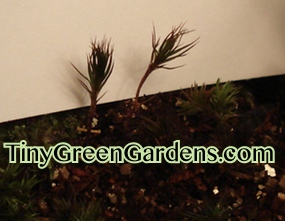
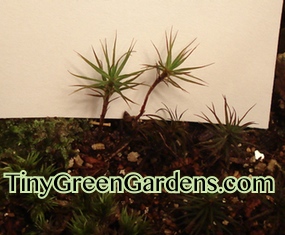
Of the varying climates I’ve created with the 2015 moss garden experiment; this mystery moss seems to prefer the semi-enclosed glass jar. I still haven’t put the lid on my large terrarium so, it might do even better in a fully-enclosed environment – it’s not very happy in the open terrarium.
Common hair cap moss is found in most parts of the world. I’ve read everything from it doesn’t mind being dry to it likes things moist. All I can say to that is that mine closes up when the soil gets dry. Some articles said it can grow to 20cm tall. Again, a mistake that is being repeated all over the web. The Dawsonia genus can grow that tall. However, hair cap moss, while in the same family of Polytrichaceae, does not generally grow taller than 2-5cm. (Mine’s a little under an inch.)
I found my hair cap moss growing in two places and both patches were close to old stumps. The soil was forest loam over red clay. One person selling hair cap moss did say that it liked clay and sandy soil. The hair cap moss was also growing with several other mosses. While I found those other mosses growing alone in our woods, I did not find hair cap growing by itself. Far from a scientific finding, but perhaps hair cap generally doesn’t grow by itself.
Unlike other mosses, hair cap has roots. My little pieces generally had a single tap root though some were growing along a single vine-like root.
Hair cap moss has male and female plants. The scientists have a lot of fancy names for what goes on, but it’s similar to pollination in that material from male plants are used by the female plants to produce spores. The spores form in a calyptra (you can see one in the first photo in this post) which grows at the end of a long stem – I have one that’s about 2.5 inches long. When the calyptra first forms, there’s little hairs at the base of it; which is where the name hair cap moss comes from.
Of the hair cap moss I have growing inside, the moss in the most enclosed and therefore humid container appears to be the happiest. It gets primarily general daylight (though, it is in the brightest room in the house). I do put it in the window to get some filtered afternoon sun now and again. It also benefits from being very close to my desk light with one of those new-fanguled fluorescent lights – the ones with tubes that are often used in Ott-Lights. Along with light, it also throws off quite a bit of heat. My hair cap moss gets a dose of desk light for a few hours 3-4 times a week.
Buying Haircap Moss
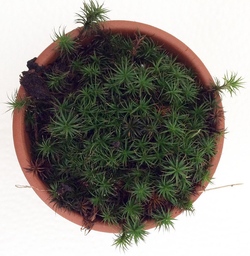 If you’re not lucky enough to have hair cap moss growing in your backyard or somewhere where you would be allowed to harvest a bit, you might want to check out Moss Acres.
If you’re not lucky enough to have hair cap moss growing in your backyard or somewhere where you would be allowed to harvest a bit, you might want to check out Moss Acres.
When I looked over their listing for live fresh haircap moss, there was only one review. Hopefully, that will change soon. You should receive your moss in a quart-sized bag.
As always, when buying moss make sure you are buying the type of moss you really want; i.e. preserved, dried or live.
